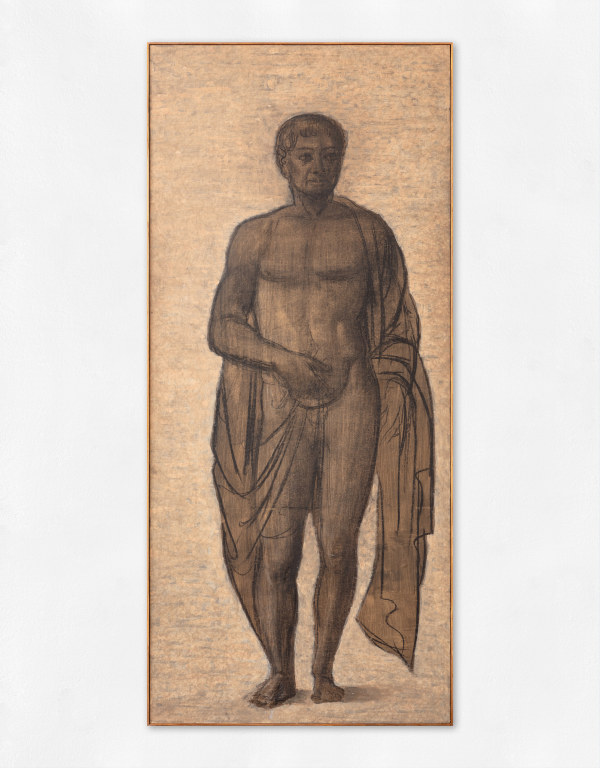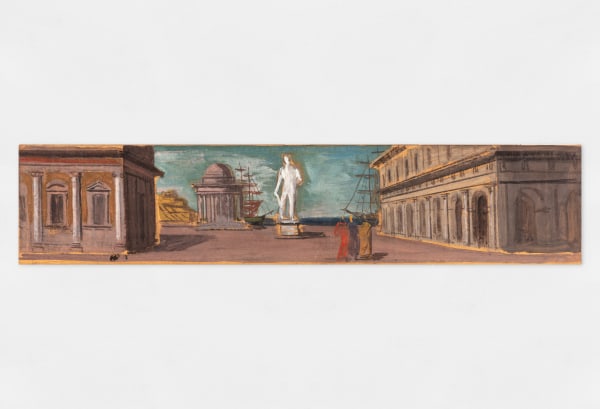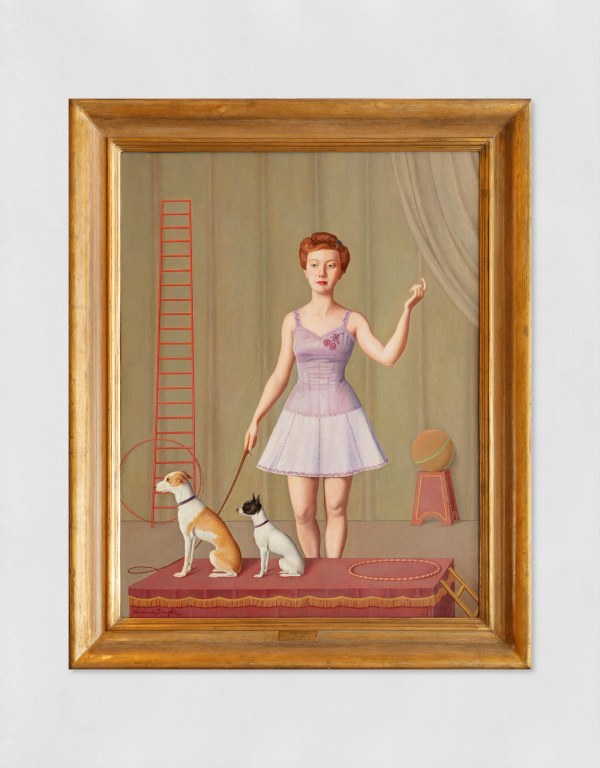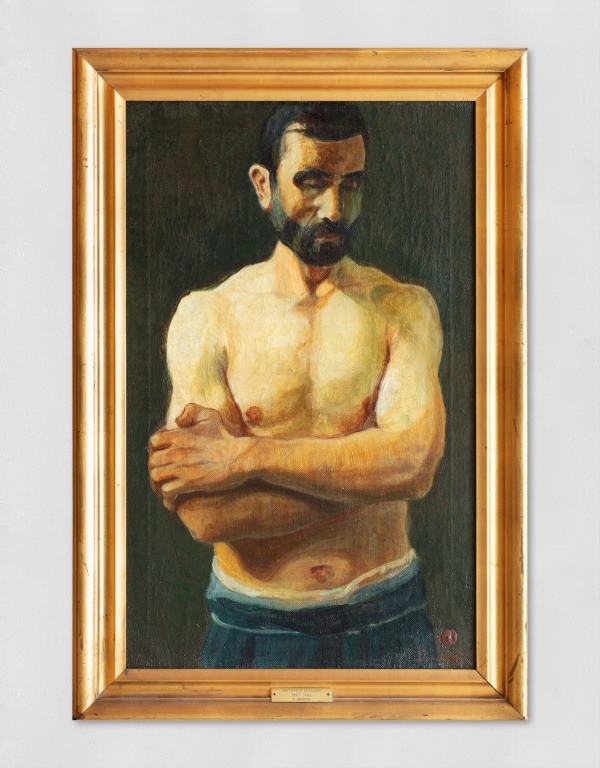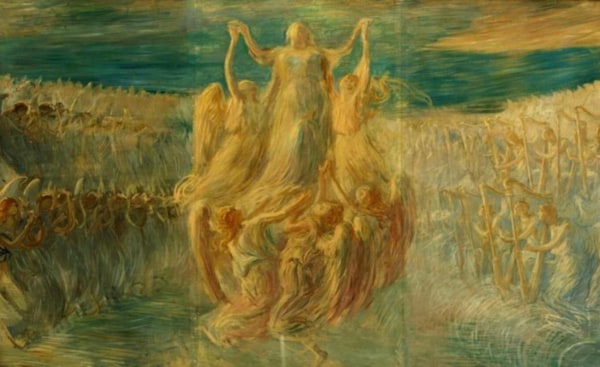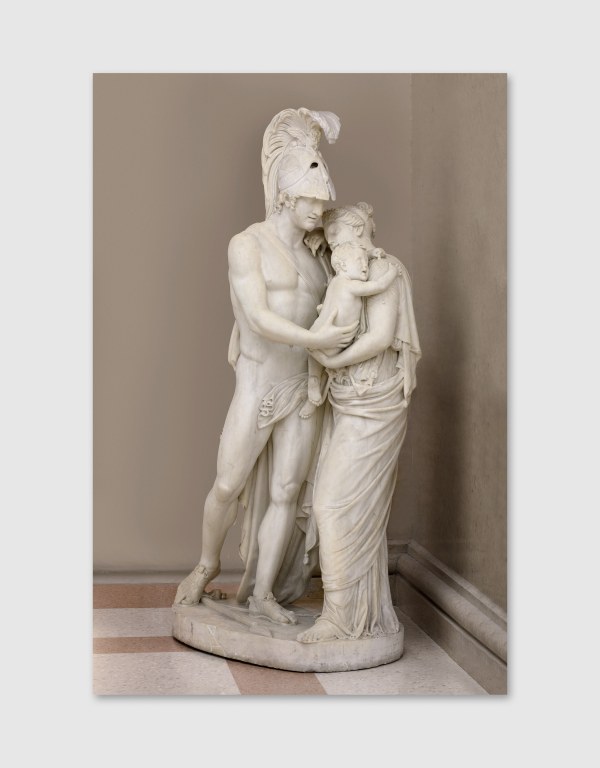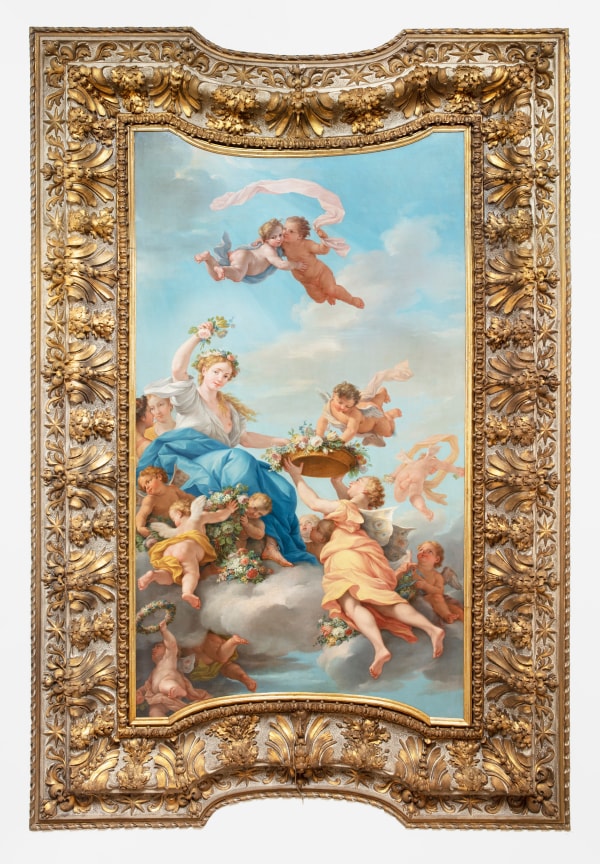-
 Achille Virgilio Socrate Funi, Statua classica con panneggio, 1951View details
Achille Virgilio Socrate Funi, Statua classica con panneggio, 1951View details -
 Achille Virgilio Socrate Funi, Visione di una città ideale Figure in uno sfondo architettonico con scultura, 1951View details
Achille Virgilio Socrate Funi, Visione di una città ideale Figure in uno sfondo architettonico con scultura, 1951View details -
 Achille Virgilio Socrate Funi, Visione di una Città ideale. Edifici, colonnati, tempio in costruzione, statua centrale, personaggi sulla piazza e porto sullo sfondo, 1951View details
Achille Virgilio Socrate Funi, Visione di una Città ideale. Edifici, colonnati, tempio in costruzione, statua centrale, personaggi sulla piazza e porto sullo sfondo, 1951View details -
 Achille Virgilio Socrate Funi, Visione di una Città ideale. Figure su fondale architettonico di ispirazione classica, 1951View details
Achille Virgilio Socrate Funi, Visione di una Città ideale. Figure su fondale architettonico di ispirazione classica, 1951View details -
 Achille Virgilio Socrate Funi, Visione di una città ideale. Porto con tempietto, palazzo, colonnati e figure., 1951View details
Achille Virgilio Socrate Funi, Visione di una città ideale. Porto con tempietto, palazzo, colonnati e figure., 1951View details -
 Antonio Donghi, Donna Che Fuma, 1950View details
Antonio Donghi, Donna Che Fuma, 1950View details -
 Gino Severini, Natura morta astratta con pera, 1949-50View details
Gino Severini, Natura morta astratta con pera, 1949-50View details -
 Felice Casorati, Fiori, 1948View details
Felice Casorati, Fiori, 1948View details -
 Renato Guttuso, Stufa a legna, 1948View details
Renato Guttuso, Stufa a legna, 1948View details -
 Antonio Donghi, Villa fuori le mura, 1947View details
Antonio Donghi, Villa fuori le mura, 1947View details -
 Antonio Donghi, Castello (Arsoli), 1946View details
Antonio Donghi, Castello (Arsoli), 1946View details -
 Antonio Donghi, L'ammaestratrice di cani, 1946View details
Antonio Donghi, L'ammaestratrice di cani, 1946View details -
 Antonio Donghi, Paesaggio (Veduta di Città di Castello), 1946View details
Antonio Donghi, Paesaggio (Veduta di Città di Castello), 1946View details -
 Renato Guttuso, Paesaggio romano (Villa Medici), 1946View details
Renato Guttuso, Paesaggio romano (Villa Medici), 1946View details -
 Antonio Donghi, Ritratto di donna, 1944View details
Antonio Donghi, Ritratto di donna, 1944View details -
 Antonio Donghi, Caccia Alle Allodole, 1942View details
Antonio Donghi, Caccia Alle Allodole, 1942View details -
 Antonio Donghi, Ragazzo, 1942View details
Antonio Donghi, Ragazzo, 1942View details -
 Antonio Donghi, Ritratto di Madre e Figlia (Lucia Praz), 1942View details
Antonio Donghi, Ritratto di Madre e Figlia (Lucia Praz), 1942View details -
 Antonio Donghi, Valle violata, 1942View details
Antonio Donghi, Valle violata, 1942View details -
 Antonio Donghi, Paesaggio, 1940View details
Antonio Donghi, Paesaggio, 1940View details -
 Felice Casorati, Le sorelle Pontorno, 1937View details
Felice Casorati, Le sorelle Pontorno, 1937View details -
 Antonio Donghi, Il Giocoliere, 1936View details
Antonio Donghi, Il Giocoliere, 1936View details -
 Filippo De Pisis, L'atelier dell'artista, 1936View details
Filippo De Pisis, L'atelier dell'artista, 1936View details -
 Felice Casorati, Donna con manto o Ragazza seduta con coperta, 1935View details
Felice Casorati, Donna con manto o Ragazza seduta con coperta, 1935View details -
 Antonio Donghi, Fiori, 1935View details
Antonio Donghi, Fiori, 1935View details -
 Antonio Donghi, Fruttiera su un tavolo, 1935View details
Antonio Donghi, Fruttiera su un tavolo, 1935View details -
 Carlo Carrà, L'Aia, 1928View details
Carlo Carrà, L'Aia, 1928View details -
 Jean Fautrier, Le vallon , 1928View details
Jean Fautrier, Le vallon , 1928View details -
 Giuseppe Graziosi, Piacenza medievale, 1927 circaView details
Giuseppe Graziosi, Piacenza medievale, 1927 circaView details -
 Giuseppe Graziosi, Piacenza moderna, 1927 circaView details
Giuseppe Graziosi, Piacenza moderna, 1927 circaView details -
 Giorgio de Chirico, Bosco silente, 1927View details
Giorgio de Chirico, Bosco silente, 1927View details -
 Beppe Ciardi, La pace sull'altipiano, 1927View details
Beppe Ciardi, La pace sull'altipiano, 1927View details -
 Lidio Ajmone, Pozzo al villaggio indigeno Amornin - Mogadiscio, 1926View details
Lidio Ajmone, Pozzo al villaggio indigeno Amornin - Mogadiscio, 1926View details -
 Giorgio Morandi, Paesaggio, 1925View details
Giorgio Morandi, Paesaggio, 1925View details -
 Antonio Donghi, Veduta di Roma, Chiesa di S. Anastasia al Palatino, 1925View details
Antonio Donghi, Veduta di Roma, Chiesa di S. Anastasia al Palatino, 1925View details -
 Giorgio de Chirico, Corazze e cocomeri, 1924View details
Giorgio de Chirico, Corazze e cocomeri, 1924View details -
 Antonio Donghi, La Fontana dei Cavalli Marini, 1923View details
Antonio Donghi, La Fontana dei Cavalli Marini, 1923View details -
 Amedeo Bocchi, Il Granturco, 1922View details
Amedeo Bocchi, Il Granturco, 1922View details -
 Antonio Donghi, Il Minatore, 1922View details
Antonio Donghi, Il Minatore, 1922View details -
 Maurice Utrillo, Casa con bandiera (houilles -seime et oise- les balles vues), 1920View details
Maurice Utrillo, Casa con bandiera (houilles -seime et oise- les balles vues), 1920View details -
 Ottorino Davoli, Il frutto della terra, 1920View details
Ottorino Davoli, Il frutto della terra, 1920View details -
 Ottorino Davoli, Il lavoro della terra, 1920View details
Ottorino Davoli, Il lavoro della terra, 1920View details -
 Felice Casorati, Paesaggio La Casa, 1920View details
Felice Casorati, Paesaggio La Casa, 1920View details -
 Maurice Utrillo, Le restaurant 'A mon idee', 1917View details
Maurice Utrillo, Le restaurant 'A mon idee', 1917View details -
 Angelo Morbelli, Raggi di sole, 1917View details
Angelo Morbelli, Raggi di sole, 1917View details -
 Giacomo Balla, La Guerra, 1916View details
Giacomo Balla, La Guerra, 1916View details -
 Lionello Balestrieri, Donna che suona il violoncello e tre fanciulle in ascolto, o Concerto in famiglia, 1914 - 1920 circaView details
Lionello Balestrieri, Donna che suona il violoncello e tre fanciulle in ascolto, o Concerto in famiglia, 1914 - 1920 circaView details -
 Enrico Reycend, Meriggio di maggio nei Dintorni di Ivrea, 1912View details
Enrico Reycend, Meriggio di maggio nei Dintorni di Ivrea, 1912View details -
 Giorgio de Chirico, Vaso di crisantemi, 1912View details
Giorgio de Chirico, Vaso di crisantemi, 1912View details -
 Gaetano Previati, L'Assunzione, 1901 circaView details
Gaetano Previati, L'Assunzione, 1901 circaView details -
 Onorato Carlandi, Villa Borghese, 1886View details
Onorato Carlandi, Villa Borghese, 1886View details -
 Francesco Paolo Michetti, Zia Luisa, 1881-1883 circaView details
Francesco Paolo Michetti, Zia Luisa, 1881-1883 circaView details -
 Silvio Allason, I primi raggi sul Monte Bianco, 1881View details
Silvio Allason, I primi raggi sul Monte Bianco, 1881View details -
 Giuseppe Camino (attribuito a), Paesaggio di Montagna, 1859View details
Giuseppe Camino (attribuito a), Paesaggio di Montagna, 1859View details -
 Domenico Induno, I Profughi del Villaggio Incendiato, 1854?View details
Domenico Induno, I Profughi del Villaggio Incendiato, 1854?View details -
 Giuseppe De Fabris, Addio di Ettore ad Andromaca, 1817View details
Giuseppe De Fabris, Addio di Ettore ad Andromaca, 1817View details -
 Francisco José de Goya y Lucientes, Marquesa de Caballero, 1807View details
Francisco José de Goya y Lucientes, Marquesa de Caballero, 1807View details -
 Jacques-Louis David, Anne-Marie-Louise Thélusson, Comtesse de Sorcy, 1790View details
Jacques-Louis David, Anne-Marie-Louise Thélusson, Comtesse de Sorcy, 1790View details -
 George Romney, Catherine Clements, 1788View details
George Romney, Catherine Clements, 1788View details -
 Pietro Antonio Novelli, Scipione parte per l’esilio, 1777View details
Pietro Antonio Novelli, Scipione parte per l’esilio, 1777View details -
 Pietro Fabris, Veduta di Palermo (cattedrale), 1770View details
Pietro Fabris, Veduta di Palermo (cattedrale), 1770View details -
 Pietro Fabris, Veduta di Palermo (Piazza Vigliena), 1770View details
Pietro Fabris, Veduta di Palermo (Piazza Vigliena), 1770View details -
 Ubaldo Gandolfi, La visione di san Camillo de Lellis, 1765-1768View details
Ubaldo Gandolfi, La visione di san Camillo de Lellis, 1765-1768View details -
 Ubaldo Gandolfi, Cristo e la Cananea, 1760-1765 circaView details
Ubaldo Gandolfi, Cristo e la Cananea, 1760-1765 circaView details -
 François Boucher, Madame de Pompadour, 1756View details
François Boucher, Madame de Pompadour, 1756View details -
 Jean-Marc Nattier, Die Marquise de Baglion als Flora (The Marquise de Baglion as Flora), 1746View details
Jean-Marc Nattier, Die Marquise de Baglion als Flora (The Marquise de Baglion as Flora), 1746View details -
 Damien Carpentiers, Ritratto del Cardinale Pompeo Aldrovandi, 1736View details
Damien Carpentiers, Ritratto del Cardinale Pompeo Aldrovandi, 1736View details -
 Giuseppe Maria Crespi, known as lo Spagnuolo, and Bottega, San Giovanni Battista battezza le folle, 1730 circaView details
Giuseppe Maria Crespi, known as lo Spagnuolo, and Bottega, San Giovanni Battista battezza le folle, 1730 circaView details -
 Giuseppe Maria Crespi, known as lo Spagnuolo, and Bottega, Strage degli innocenti, 1730 circaView details
Giuseppe Maria Crespi, known as lo Spagnuolo, and Bottega, Strage degli innocenti, 1730 circaView details -
 Gaetano Cittadini, Paesaggio con Erminia tra i pastori, 1729View details
Gaetano Cittadini, Paesaggio con Erminia tra i pastori, 1729View details -
 Sebastiano Conca, Allegoria, 1726 circaView details
Sebastiano Conca, Allegoria, 1726 circaView details -
 Domenico Maria Muratori (Attribuito a), Allegoria, 1725 circaView details
Domenico Maria Muratori (Attribuito a), Allegoria, 1725 circaView details -
 Jacopo Amigoni, Putti che giocano con cane, 1725View details
Jacopo Amigoni, Putti che giocano con cane, 1725View details -
 Jacopo Amigoni, Putti che giocano con coniglio, 1725View details
Jacopo Amigoni, Putti che giocano con coniglio, 1725View details -
 Ludovico Mazzanti, Gli Zefiri scacciano l'inverno, 1720-1722 circaView details
Ludovico Mazzanti, Gli Zefiri scacciano l'inverno, 1720-1722 circaView details -
 Ludovico Mazzanti, La Primavera o Flora e Zefiro, 1720-1722 circaView details
Ludovico Mazzanti, La Primavera o Flora e Zefiro, 1720-1722 circaView details -
 Luigi Garzi, Apollo guida il carro del Sole , 1720 circaView details
Luigi Garzi, Apollo guida il carro del Sole , 1720 circaView details -
 Giuseppe Bartolomeo Chiari, Bacco, Venere e Cerere, 1720 circaView details
Giuseppe Bartolomeo Chiari, Bacco, Venere e Cerere, 1720 circaView details -
 Benedetto Luti, Diana come personificazione della Luna o Allegoria con Diana, le Ninfe, gli Zefiri ed Eroti (La Notte), 1720 circaView details
Benedetto Luti, Diana come personificazione della Luna o Allegoria con Diana, le Ninfe, gli Zefiri ed Eroti (La Notte), 1720 circaView details -
 Andrea Procaccini, Allegoria dell'Aurora, 1720 caView details
Andrea Procaccini, Allegoria dell'Aurora, 1720 caView details
Page
5
of 7

